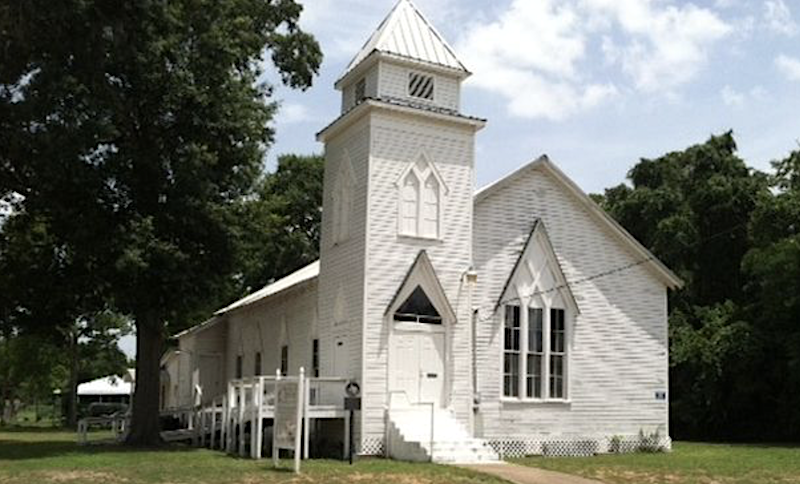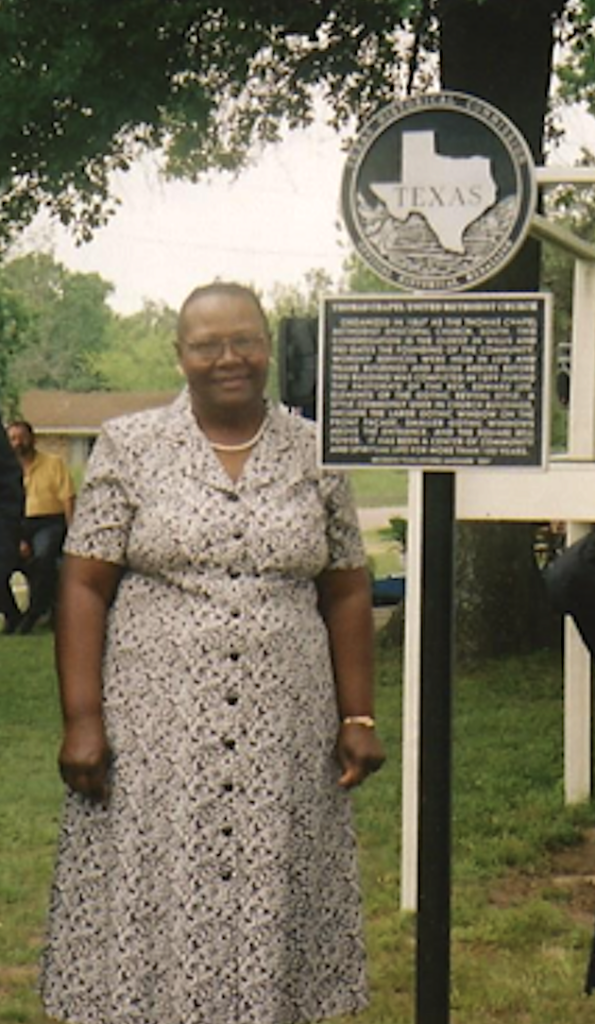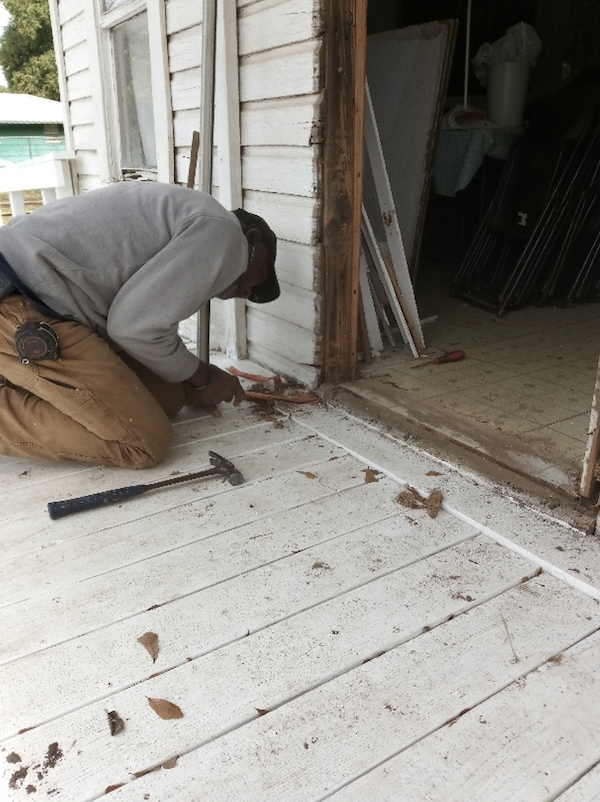
By Lindsay Peyton
When Ann Meador first passed by Thomas Chapel UMC in Willis, the historic church took her breath away. “You drive down the street, and you just don’t expect it,” she said. “It’s Victorian Gothic architecture, and very impressive.”
Then, she stopped and talked to the members – and discovered that the story behind the church was even more spectacular. “It has a Texas State Landmark out front – and it’s the oldest, continuously used church in Montgomery County,” she said.
And that is just part of what makes Thomas Chapel unique. The congregation can trace its origins back to the 1867s with a group of ex-slaves coming out of Danville Community to an area that would eventually become the city of Willis, Texas. Since that time, the church has remained a force for community and education for Black residents of Willis.

Meador soon learned, however, that the church was in dire need of repair. She vowed, “We’re not going to let this go downhill.”
After all, Meador, a retired journalism professor from Sam Houston State University, established the nonprofit Montgomery County History Task Force. She launched the endeavor two years ago, shortly after her appointment as a member of the county’s Historical Commission.
“Our slogan is ‘History is a perishable commodity. And when it’s gone, it’s gone forever,’” Meador said.
She is especially dedicated to preserving Black history, which has often been left out of the picture and the archives. “So much is lost,” she said. And she wants to change that.
Meador also has a more personal reason for wanting to lend a hand at Thomas Chapel. Her sixth great grandfather William Stevenson is known as a father of Methodism in Louisiana and Texas.
Born Oct 4, 1768 in South Carolina, Stevenson died on Feb. 4, 1857 in Claiborne Parish, Louisiana, where Meador was raised. He was a circuit rider in the 1830s and a friend to Moses Austin and his son Stephen F. Austin.
Before Texas was annexed to the U.S., Stevenson defied the rule and preached as a Methodist, when Catholiscim was the state’s only allowed religion. His sons became Methodist ministers and most of his daughters also married Methodist ministers.
Looking at Thomas Chapel, and thinking about the needed renovation, Meador told herself, “I’m taking this on for ol’ William.”
Joining hands to help the church
Meador soon found an ally in the project. Another member of the History Task Force, Cynthia Stubblefield Walker, also had a personal interest in helping Thomas Chapel.
“It was my grandmother’s church,” Stubblefield Walker said.
Thomas Chapel is where her father grew up, and she also spent many Sundays in the pews during her own childhood, visiting Willis on weekends from her home in La Marque.
Stubblefield Walker, who now works as a reading intervention specialist, still goes to the church for family day and other events. Her cousins serve on the church’s board of trustees.

One of her cousins, the late Nancy Thompson Jackson, was instrumental in the administration of Thomas Chapel. “She was the glue for the congregation for a long time,” Stubblefield Walker said. “When Nancy died in 2016, it was like no one knew what to do.”
That’s when the repairs on the historic building started adding up. At the same time, the congregation was getting smaller, and members were aging, making it more difficult to get the funds necessary for a renovation.
Stubblefield Walker was excited to learn that Meador wanted to get involved. The two met when the Task Force began working on nearby Rest Haven Cemetery.
“Ann decided that the church needed to be leveled,” Stubblefield Walker said. “And she jumped all in, bringing an engineer and coming up with a list of projects the church needed pretty urgently.”
Meador told Stubblefield Walker, “I know if my grandfather was here, he’d get a kick out of this church.”
“It’s in honor of my ancestors too,” Stubblefield Walker said.
A historic landmark
Long before a building stood at 512 Martin Luther King Blvd, there was a brush arbor where slaves gathered to worship. After Emancipation, now freed men raised a log cabin at the site. This was all before the city of Willis even existed, Meador explained.
The town came with the International and Great Northern Railroad. In the 1870s, the Texas Land Company came to plat the town. At that time, the log cabin was officially given to its congregation as a church site.
Then, in 1899, the sons and grandsons of the formerly enslaved people of the Greenwood Plantation replaced the structure, building the current landmark church. Their names are inscribed on the cornerstone of the building – and include Stubblefield Walker’s family members.
“It makes you proud,” she said. “It’s been standing since 1899, and it’s sound.”
She explained that the church has always held a significant place in the town. Before schools were integrated, Thomas Chapel was a hub of education. During the Civil Rights era, the church became a center to empower Black residents to register to vote.
“It has a history of being involved in the community all these years,” Meador said. “It’s been a center of the community. I’d like to see it continue to be.”
Stubblefield Walker said that membership in Thomas Chapel has declined over the years, with only about 20 regulars on a Sunday.
Still, she explained, the neighborhood is growing. “The whole area is being revitalized,” she said. “There’s a huge subdivision being built. I feel like they definitely have potential for a lot of growth.”
Starting the renovation
In the fall of 2021, Phase I of the restoration began, including the repair and leveling of the building’s foundation. The Heritage Museum of Conroe sponsored the leveling of the building and was reimbursed with funding from the Montgomery County Historical Commission.
Using private funds, Meador began Phase II of the chapel’s restoration, which included constructing a rear entry handicap ramp, repairing the men’s restroom, replacing air conditioner duct work, extending the sewer pipe and replacing all water pipes.

Master carpenter Rev. Orbra Toliver, pastor of Toliver Memorial Church of God in Willis, has taken the lead on the construction projects and has worked at a fraction of his usual rate.
Raccoon damage was also a major concern, Stubblefield Walker said. The animals had damaged ductwork, chewed into the floor and were climbing into the bell tower of the church. Lattice work was placed around the foundation of the building to prevent the raccoons from returning.
The rear entry door was also replaced, and the door frame rebuilt.
“It’s been a great project,” Stubblefield Walker said. “I told Ann, ‘I can’t thank you enough.’”
More work needed
Meador still has a list of work needed, including repairs to the standing metal seam roof estimated at $15,000 and updates to the heating/cooling system, which could cost $10,000. In addition, the building’s façade has water damage, an estimated $18,000 to repair. The church is applying for grants but is also in need of individual donations to keep the project alive.
“I’m not a member of the church, but I want to see the church grow,” Meador said. “I’d like to see it around for another 100 years.” Stubblefield Walker agreed. “We have several large projects still needing to be done, but I’m optimistic,” she said. Restoring Thomas Chapel is an important step to preserving Black history in Texas.
“We have to tell these stories,” Stubblefield Walker said. “We need people to step up. All of us have to take ownership. Everyone should see the value of maintaining a historic structure like this. And Thomas Chapel is one of a kind.” “The church is so significant,” she added. “We have to save it.”
To help, contact Meador at or visit the Friends of Thomas Chapel Facebook page for more information.
